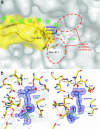Crystal structures of gamma-glutamyltranspeptidase from Escherichia coli, a key enzyme in glutathione metabolism, and its reaction intermediate
- PMID: 16618936
- PMCID: PMC1458908
- DOI: 10.1073/pnas.0511020103
Crystal structures of gamma-glutamyltranspeptidase from Escherichia coli, a key enzyme in glutathione metabolism, and its reaction intermediate
Abstract
Gamma-glutamyltranspeptidase (GGT) is a heterodimic enzyme that is generated from the precursor protein through posttranslational processing and catalyzes the hydrolysis of gamma-glutamyl bonds in gamma-glutamyl compounds such as glutathione and/or the transfer of the gamma-glutamyl group to other amino acids and peptides. We have determined the crystal structure of GGT from Escherichia coli K-12 at 1.95 A resolution. GGT has a stacked alphabetabetaalpha fold comprising the large and small subunits, similar to the folds seen in members of the N-terminal nucleophile hydrolase superfamily. The active site Thr-391, the N-terminal residue of the small subunit, is located in the groove, from which the pocket for gamma-glutamyl moiety binding follows. We have further determined the structure of the gamma-glutamyl-enzyme intermediate trapped by flash cooling the GGT crystal soaked in glutathione solution and the structure of GGT in complex with l-glutamate. These structures revealed how the gamma-glutamyl moiety and l-glutamate are recognized by the enzyme. A water molecule was seen on the carbonyl carbon of the gamma-glutamyl-Thr-391 Ogamma bond in the intermediate that is to be hydrolyzed. Notably the residues essential for GGT activity (Arg-114, Asp-433, Ser-462, and Ser-463 in E. coli GGT) shown by site-directed mutagenesis of human GGT are all involved in the binding of the gamma-glutamyl moiety. The structure of E. coli GGT presented here, together with sequence alignment of GGTs, may be applicable to interpret the biochemical and genetic data of other GGTs.
Conflict of interest statement
Conflict of interest statement: No conflicts declared.
Figures




Similar articles
-
Crystal structures of Escherichia coli gamma-glutamyltranspeptidase in complex with azaserine and acivicin: novel mechanistic implication for inhibition by glutamine antagonists.J Mol Biol. 2008 Jul 4;380(2):361-72. doi: 10.1016/j.jmb.2008.05.007. Epub 2008 May 12. J Mol Biol. 2008. PMID: 18555071
-
Evidences on the role of the lid loop of γ-glutamyltransferases (GGT) in substrate selection.Enzyme Microb Technol. 2018 Jul;114:55-62. doi: 10.1016/j.enzmictec.2018.04.001. Epub 2018 Apr 4. Enzyme Microb Technol. 2018. PMID: 29685354
-
Crystal structure of the halotolerant gamma-glutamyltranspeptidase from Bacillus subtilis in complex with glutamate reveals a unique architecture of the solvent-exposed catalytic pocket.FEBS J. 2010 Feb;277(4):1000-9. doi: 10.1111/j.1742-4658.2009.07543.x. Epub 2010 Jan 20. FEBS J. 2010. PMID: 20088880
-
γ-Glutamyltranspeptidase essential for the metabolism of γ-glutamyl compounds in bacteria and its application.Biosci Biotechnol Biochem. 2021 May 25;85(6):1295-1313. doi: 10.1093/bbb/zbab043. Biosci Biotechnol Biochem. 2021. PMID: 33713104 Review.
-
Bacterial Gamma-Glutamyl Transpeptidase, an Emerging Biocatalyst: Insights Into Structure-Function Relationship and Its Biotechnological Applications.Front Microbiol. 2021 Apr 9;12:641251. doi: 10.3389/fmicb.2021.641251. eCollection 2021. Front Microbiol. 2021. PMID: 33897647 Free PMC article. Review.
Cited by
-
Garlic γ-glutamyl transpeptidases that catalyze deglutamylation of biosynthetic intermediate of alliin.Front Plant Sci. 2015 Jan 8;5:758. doi: 10.3389/fpls.2014.00758. eCollection 2014. Front Plant Sci. 2015. PMID: 25620969 Free PMC article.
-
Divergent effects of compounds on the hydrolysis and transpeptidation reactions of γ-glutamyl transpeptidase.J Enzyme Inhib Med Chem. 2012 Aug;27(4):476-89. doi: 10.3109/14756366.2011.597748. Epub 2011 Aug 24. J Enzyme Inhib Med Chem. 2012. PMID: 21864033 Free PMC article.
-
Heterogeneous nucleation helps the search for initial crystallization conditions of γ-glutamyl transpeptidase from Bacillus licheniformis.Acta Crystallogr Sect F Struct Biol Cryst Commun. 2013 Jun;69(Pt 6):669-72. doi: 10.1107/S1744309113012165. Epub 2013 May 25. Acta Crystallogr Sect F Struct Biol Cryst Commun. 2013. PMID: 23722850 Free PMC article.
-
Preclinical Evaluation of a Potential GSH Ester Based PET/SPECT Imaging Probe DT(GSHMe)₂ to Detect Gamma Glutamyl Transferase Over Expressing Tumors.PLoS One. 2015 Jul 29;10(7):e0134281. doi: 10.1371/journal.pone.0134281. eCollection 2015. PLoS One. 2015. PMID: 26221728 Free PMC article.
-
Gamma-glutamyl transferase secreted by Helicobacter pylori promotes the development of gastric cancer by affecting the energy metabolism and histone methylation status of gastric epithelial cells.Cell Commun Signal. 2024 Aug 15;22(1):402. doi: 10.1186/s12964-024-01780-x. Cell Commun Signal. 2024. PMID: 39148040 Free PMC article.
References
Publication types
MeSH terms
Substances
Associated data
- Actions
- Actions
- Actions
LinkOut - more resources
Full Text Sources
Other Literature Sources
Molecular Biology Databases
Miscellaneous

